January 18, 2008
Air Date: January 18, 2008
FULL SHOW
SEGMENTS
Biofuel the Best Bet?
View the page for this story
The European Union is re-thinking its commitment to use ten percent biofuel in vehicles because of growing concerns about some of the fuel’s sources, including corn, sugar and palm oil. Host Bruce Gellerman turns to Jim Lane, chairman of the American Biofuels Council, to get the latest on the future of biofuels. (05:20)
A Spoonful of CAFÉ / Dan Becker
View the page for this story
Environmental lawyer Dan Becker says that Americans who want to pass strong global warming legislation might take a cue from environmentalists who finally surpassed Detroit automakers’ opposition to higher vehicle fuel standards after a two decade struggle. (03:15)
Waste Not....Here
View the page for this story
Plans to store radioactive nuclear waste in Yucca Mountain, Nevada have been postponed again due to budget cuts and opposition. Host Bruce Gellerman turns to Lisa Mascaro, Washington correspondent for the Las Vegas Sun. (03:30)
Cloned Little Piggies Going to Market? / Jeff Young
View the page for this story
The FDA says meat and milk from cloned animals is safe to eat. But Living on Earth's Jeff Young tells us Congress and consumers aren't so sure. And food safety expert and author Marion Nestle tells us whether food from clones could end up at your local market. (06:30)
From Toilet to Tap / Ingrid Lobet
View the page for this story
Orange County, CA has opened what is likely the largest sewage purification plant for drinking water in the world. The community is on board, and the idea is already being copied elsewhere in the U.S. and abroad. Living on Earth’s Ingrid Lobet reports. (06:30)
Water Calculator
View the page for this story
The average American guzzles 1,189 gallons of water a day. Want to see how you match up? A new website let's you calculate your daily water footprint- asking you pointed questions about your habits. Host Bruce Gellerman speaks with Wenonah Hauter, executive director of Food and Water Watch, one of the organizations involved in creating the new online tool. (04:20)
Geophonic Works / Ian Gray
View the page for this story
We've heard a lot about climate change in the news over the past few years, but how many of us have actually heard climate change itself? Composer Arvid Tomayako-Peters takes listeners on a musical voyage back through five million years of Earth's climate history. (07:30)
Cool Fix For a Hot Planet / Sandy Kappelmann
View the page for this story
Looking for tips on how to lower your carbon footprint? California listener Sandy Kappelmann tells us how her family saves water and electricity doing the dishes. (01:30)
Wireless Science / Jean Kumagai
View the page for this story
It’s fast, it’s reliable, and it’s transforming how scientists do their research. IEEE Spectrum Radio’s Jean Kumagai reports on a wireless sensor network called HP-WREN. (06:50)
This week's EarthEar selection
listen /
download
Show Credits and Funders
Show Transcript
HOST: Bruce Gellerman
GUESTS: Wenonah Hauter, Sandy Kappelmann, Jim Lane, Lisa Mascaro, Marion Nestle
REPORTERS: Ian Gray, Jean Kumagai, Ingrid Lobet, Jeff Young
COMMENTATORS: Dan Becker
[THEME]
From Public Radio International—this is Living on Earth.
[THEME]
GELLERMAN: I’m Bruce Gellerman. It’s modern day alchemy designed to save the planet. And everybody’s doing it—spinning hay and other plants into black gold.
LANE: The Arabian Countries are getting involved in biofuel development. The Emirate of Abu Dhabi has got a major program going on, because they see it as the future—or rather a big part of it.
GELLERMAN: But critics charge today’s biofuels are hurting, not helping, the environment. And another Rumpelstilskin trick—toilet to tap—transforming wastewater into liquid gold.
HELLEBRAND: The school kids come through, and they're kind of looking for that yuck factor, and by the time they get the end of the process the water is so clean, you almost want to drink it.
GELLERMAN: And Yucc– a – the Nevada nuclear site, that is—transforming radioactivity into hot debate – those stories and more this week on Living on Earth. Stick around!
Biofuel the Best Bet?
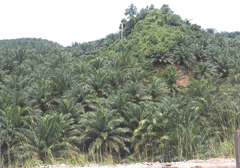
(Flickr/Badly Drawn Dad)
GELLERMAN: From the Jennifer and Ted Stanley Studios in Somerville, Massachusetts—this is Living on Earth. I’m Bruce Gellerman, in for Steve Curwood. Growing fears of global warming and our dependence on foreign oil, as well as soaring gas prices, have accelerated interest in biofuels…petroleum substitutes made from plants.
General Motors and Virgin Atlantic think the future of biofuels is bright. They’ve recently made major announcements involving plant-grown energy. But the European Union is taking a dim view of biofuels. To help sort the wheat from the chaff we turn to Jim Lane, editor of the online daily “Biofuels Digest” and chairman of the American Biofuels Council. Welcome, Jim.
LANE: Hi Bruce.
GELLERMAN: So when I say biofuels, exactly what, what am I talking about?
LANE: Biofuels are made from biomass, that is plants. They can be made from waste materials, they can be made from citrus peel, they could be made form wood chips, a lot of stuff that you wouldn’t think you could turn into fuel, and through a chemical process are transformed into something that you can put in your engine. And the good news there is because they use carbon when they’re grown, they take the carbon out of the sky, so what we’re putting into the sky when we burn a biofuel is just the carbon they took out in the first place, and that’s a good cycle, so they’re called carbon neutral and that’s why we like them.
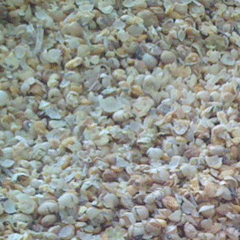
Soybeans and soybean hulls. Soybean oil is the most common feedstock for first-generation biodiesel in the United States. Soybean hulls are a feedstock for second generation biofuels that use waste products, rather than foodstocks, to make fuel. (Photo: Jim Lane)
LANE: What the E.U. is saying is to think sustainable, not renewable. Not all renewable fuels are alike. Some of them can be made, for instance palm oil biodiesel can be made in Indonesia by deforesting large sections of primeval forest and not only is that bad for biodiversity, but it’s actually bad for the environment, because it releases a ton of carbon when we take down the forest so it sort of defeats the purpose, and what the E.U. is saying is let’s use renewable fuels, let’s do the right thing, let’s do it in a sustainable manner, and so in that sense they’re not really turning against biofuels, they’re actually leading us to a better biofuel.
GELLERMAN: Well, what could be a better biofuel?
LANE: A second-generation biofuel is made instead of from a food stock it’s made from waste. And that can be turned into fuel at a much lower cost than let’s say converting soy or corn into ethanol. So it’s good for the consumer on the cost frontier, it’s better for the environment, and it’s certainly using products that we don’t have any use for right now. So that’s, it’s really a win, win win if you will, and we’re all for it. The problem is whether it’s commercially viable and that’s something we’re exploring right now.
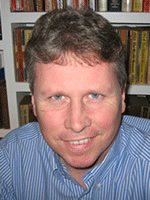
Jim Lane (Courtesy of Jim Lane)
LANE: This is a very exciting technology, it’s one of several out there. Its primary attribute is that it’s very low cost, and it has a low environmental impact. So it’s a, it’s a good sign that GM is getting serious about having long-term environmental and fuel strategy, and more power to them.
GELLERMAN: Well Virgin Atlantic airline says it’s going to fly an experimental plane in February fueled by biofuel. But they’re being very secretive about exactly which fuel they’re going to use.

Algae oil igniting in a biofuel production test. Algae is one of the most promising feedstocks for biofuels: it can yield up to 10,000 gallons per acre, consume carbon dioxide and grow in desert areas. (Photo: Jim Lane)
GELLERMAN: So it seems to me that these places that are rich in agricultural land and products could one day become basically the Saudi Arabias of the future.

Palm oil has become highly controversial as a biofuel feedstock because of deforestation practices in Southeast Asia. This photo of a palm oil plantation was taken in Borneo. (Photo: Flickr/Badly Drawn Dad http://www.flickr.com/photos/dhedwards/215383747/)
LANE: Yeah that’s very true. And that’s something that a lot of African countries are looking at. They have tremendous growing capabilities. They have a lot of land available and they have wonderful tropical characteristics. But also the Arabian countries are getting involved in biofuel development. The emirate of Abu Dhabi has got a major project going on because they see this as the future, or certainly a big part of it. So every community in the world should be looking at what they can do to develop a meaningful biofuels strategy, and not just become a consumer, but a sustainable producer and be part of the solution, and also build jobs and build a stronger economy for themselves. And that’s what’s happening in India and Africa and it’s a great story for those places that have been economically challenged for so long.
GELLERMAN: Jim Lane is editor of the online daily “Biofuels Digest” and chairman of the American Biofuels Council. Well Jim, thank you very much.
LANE: Thank you, Bruce.
Related links:
- Daily Digest on Biofuels, edited by Jim Lane
- The American Biofuels Council
A Spoonful of CAFÉ
GELLERMAN: Well, GM and the other U.S. automakers are heeding the call: thar’s gold in them thar plants and fuel-efficient cars. And the manufacturers are finally diggin’ the message. But environmental lawyer and commentator Dan Becker says it’s taken some kicking and screaming.
DECKER: After 30 years of making more and more gas guzzlers, Detroit is finally poised for a turnaround. The reason for the change isn’t enlightened self-interest by the likes of General Motors. It is because Congress passed a law, voting for the first time since 1975 to update the Corporate Average Fuel Economy or CAFE law that sets mile per gallon standards for cars, SUVs and other light trucks.
The new law requires automakers to make their vehicles average 35 mpg by 2020, up from 25 mpg today. This will save America over 1 million barrels of oil a day—about half our Persian Gulf imports—it will slash global warming pollution by 20 million tonnes per year, and save consumers over $20 billion at the pump. The good news is that we have won the biggest single step to curbing global warming, the most important environmental victory since the 1990 Clean Air Act. The bad news is what this effort bodes for the next Congressional climate battle.
To win, environmentalists had to fight auto companies for nearly 20 years. We blasted the Big Three automakers’ opposition to good laws and failure to make clean cars. When Honda and Toyota introduced their hybrids, we took them on a 50-city tour, showing that carmakers can produce clean vehicles despite Detroit’s denials. We took the dispute out of Washington, winning laws in nearly 20 states to cut global warming pollution from cars.
Unfortunately, auto companies and the Bush Administration have temporarily blocked these laws. But, at least one car company, Nissan, split from the industry and supported the CAFE bill because they know they will have to make clean cars for the states. Now, Congress wouldn’t have voted with us without three-dollar gas, growing public concern about global warming and a new majority and Speaker willing to take on the special interests.
This year, as Congress turns to broad climate legislation that would cap industrial emissions but allow polluters to buy and sell the right to pollute, the lessons from the CAFE bill loom. If it took a perfect storm to beat just one powerful industry, what will it take to beat the oil, coal, utility, Chamber of Commerce, and other lobbies lining up to kill or gut a strong global warming law?
Scientists warn that we have only a few years to begin to reverse the growing emissions of global warming pollution. So we can’t afford another decade-long delay. There are several ways to make progress. As they did with cars, the states can lead the way. The next President can champion the cause. Congress can tackle one polluter at a time rather than all at once.
But despite tough odds, our new mile per gallon law shows that we can win when we’re persistent, have bold leaders and the American people demand action.
GELLERMAN: Dan Becker is an environmental lawyer specializing in global warming and cars.
Waste Not....Here

Yucca Mountain, Nevada (Courtesy of The Whitehouse)
GELLERMAN: Since the 1980’s the United States has been committed to building a nuclear waste repository 90 miles northwest of Las Vegas at Yucca Mountain. The site was designed to deal with high level radioactive waste from the nation’s atomic power plants.
Yet two decades and $9 billion later, there’s a test tunnel leading a thousand feet deep into the barren basalt wasteland—but no nuclear waste. Most Nevada residents oppose the Yucca project—and in a recent debate, the top democratic presidential candidates sought their support.
GELLERMAN: Well, at long last, there may be light at the end of the Yucca Mountain debate. Joining me is Lisa Mascaro, Washington correspondent for the Las Vegas Sun. Hi, Lisa.
MASCARO: Hi, Bruce. Thanks for having me.
GELLERMAN: This is the never-say-die project, but it seems that the Department of Energy officials who are in charge of Yucca Mountain are about to miss an important deadline, right?
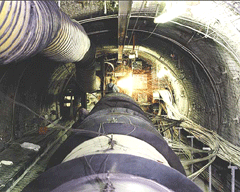
Beneath Yucca Mountain in a 47-meter-long tunnel, researchers have placed electrical heaters inside containers resembling those intended to hold high-level nuclear wastes. Numerous instruments monitor the effect of heat on the surrounding rock. Tests like these will help determine the consequences of storing nuclear waste in tunnels inside Yucca Mountain. (Courtesy of Lawrence Berkeley National Laboratory)
GELLERMAN: Well it was your Senator, Democratic Majority Leader Harry Reid, who did cut deep into this budget.
MASCARO: Absolutely. The Nevada delegation—and really the whole state of Nevada—from the government structure and a vast majority of the population of Nevada, polls show us—are opposed to this project and have been opposed to it. And the Nevada delegation here in Washington has fought for years trying to whittle away, they say—the buzzword is sort of to starve the project of its needed funds. Well, now that Senator Harry Reid is the majority leader, he has been able to engineer one of the largest budget cuts ever to the project.
GELLERMAN: Well, they’ve laid off a lot of workers and they put it on a caretaker status, basically.

Yucca Mountain, Nevada (Courtesy of The Whitehouse)
GELLERMAN: Well the Democrats are all saying ‘no way, Jose.’ What are the Republicans saying?
MASCARO: Yeah, there are—you’re absolutely right. The Democrats have come out so strong against this project, some even going so far as to say that they will be sure to kill it if they are to take office. The Republicans have been more mixed and you’ve definitely heard some of the candidates saying that the nation needs a place to put the nuclear waste and this is the place that was decided on years ago and we need to go forward with this project.
GELLERMAN: Well what happens if they really do shut down Yucca? Where does the waste go?
MASCARO: Right, Bruce. Well that’s an interesting debate and one that’s been going on for some time. There is a school of thought that says that you can store the waste exactly where it is. It can stay put at the energy producing sites across the nation. And it’s something that Senator Reid and the Nevada delegation has pushed to continue doing just that.
GELLERMAN: Lisa Mascaro is Washington correspondent with the Las Vegas Sun. Lisa, thanks a lot.
MASCARO: Thanks for having me.
GELLERMAN: Just ahead—the FDA says ‘send in the clones.’ Stay tuned to Living on Earth.
Cloned Little Piggies Going to Market?
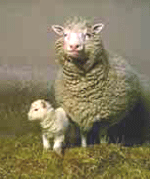
Dolly was the first mammal ever cloned. She eventually gave birth to Bonnie, the lamb next to her. (Courtesy of NIH/Roslin Institute, Edinburgh)
GELLERMAN: It’s Living on Earth. I’m Bruce Gellerman. The next time you order a double cheeseburger, you may get exactly that: twin burgers made from beef cattle that have been cloned. The U.S. Food and Drug Administration has concluded that milk and meat from cloned animals is safe to eat. But as Living on Earth’s Jeff Young reports—officials now have a food fight on their hands.
YOUNG: The FDA says its years long scientific review found food from clones virtually identical to that from other animals.
SUNDLOF: In other words, the risk assessment concludes that the meat and milk from cattle, swine, and goats are as safe to eat as the food we eat every day.
YOUNG: That’s FDA food safety director Stephen Sundlof. Sundlof says these findings are similar to those from a 2002 review by the National Academy of Sciences, and work by scientific panels in other countries. But several consumer and public health groups remain skeptical. Joe Mendelson at the advocacy group Center for Food Safety says FDA rushed to judgment and ignored concerns about the many cloned animals that die shortly after birth.
MENDELSON: It eliminates any assessment of all the cloning problems that happen to animals when they’re born and through their young age with the assumption that we’ll keep those animals out of the food supply. We think that’s an assumption that the FDA, given its track record, can’t make.
YOUNG: Congress is also upset. In an angry press release, Maryland Democratic Senator Barbara Mikulski condemned the FDA decision as reckless. She says the decision disregards language in the pending farm bill that would require more study on cloned animals. And Connecticut Democratic Representative Rosa DeLauro says spending bills also asked FDA to take more time.
DELAURO: And now we have the go ahead and we without, uh, really taking into consideration either Congress’ directive, or more importantly, the public’s uncertainty. I’m not going to make a scientific judgment. I am not a scientist. But our thought was that we ought to move more slowly.
YOUNG: DeLauro and Mikulski also proposed bills that would label any food product that came from a clone. Some 30,000 people wrote to FDA about clones and roughly half of those said they think food from a cloned animal should at least carry a label. But the FDA’s Stephen Sundlof says the agency can’t do that.
SUNDLOF: It’s not a matter of whether or not we think we should or not. It’s a matter of—do we have the authority to require that companies label their product. And clearly in this case we don’t believe that we do.

Dolly was the first mammal ever cloned. She eventually gave birth to Bonnie, the lamb next to her. (Courtesy of NIH/Roslin Institute, Edinburgh)
YOUNG: The U.S. Agriculture Department wants cloning companies to stand by a temporary moratorium on cloned food. But as for now, only that voluntary moratorium and the high cost of cloning keeps those products off your supermarket shelves. For Living on Earth, I’m Jeff Young in Washington.
GELLERMAN: But will cloned pigs fly with consumers? It’s a question for Marion Nestle, author of the books: “Safe Food” and “Food Politics: How the Food Industry Influences Nutrition and Health.” Well Professor Nestle, would you eat cloned meat?
NESTLE: Oh, I probably would if I had to but why would I want to? I can’t think of a single reason why I would want to. There’s plenty of really good beef around—naturally raised, grazed on grass, and all of those other good things. I don’t really see why we need this.
GELLERMAN: Hmm. But in the past, how successful have companies been at marketing, you know, scientific breakthroughs in food.
NESTLE: Well I’m not sure this is a scientific breakthrough. I think that remains to be seen. Whether this is something that’s just scientific or whether it has real value for consumers is something that we still have to see. When it comes to genetically modified foods, most of the benefits that we’ve seen so far have been to food producers, not to consumers.
GELLERMAN: Remember the flavor savor tomato?
NESTLE: I do. I remember it quite well. And one of the wonderful things about it was that it was going to be clearly labeled as a breakthrough in modern technology. But as it turned out it wasn’t a breakthrough because they weren’t able to produce it and so it never went on the market. They had developed the technology for temperate zone agriculture and then they tried to grow it in the south and it just didn’t grow.
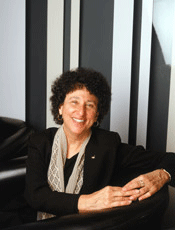
Dr. Marion Nestle (Photo: Peter Menzel)
NESTLE: Well I think every single survey that I have ever seen for the last, now almost 20 years, indicates that people are extremely suspicious of genetically modified foods or cloned animals or any of those sorts of things. They have great hesitations about them. And I think a lot of those problems could be solved if they were labeled as such so that people actually had a choice.
GELLERMAN: Yeah. I’m wondering if you had like you know, free-range chicken or organic beef—would it still be organic or would it still be free range if it came from a cloned animal?
NESTLE: Oh, I don’t think so. In fact the rules for organics specifically exclude genetically modified products.
GELLERMAN: So you think they’ll have to go the labeling route whether they want to or not?
NESTLE: They say they’re not going to label because there’s no difference between animals that are cloned and animals that are not. The FDA makes its decisions exclusively on one criterion and that’s safety for human health—whether they’ve tested enough whether—it’s, it’s very hard to prove that something is perfectly safe. But it’s probably safe enough. I don’t think that safety is the issue. Just because it’s safe doesn’t mean it’s necessarily acceptable. And that’s why this decision of the FDA’s is so—I think, in some ways, hilariously funny. Because on the same day that the FDA came out with its press release saying that these things were safe to eat and there was no reason not to eat them and off they go into the food supply, the Department of Agriculture said, ‘please don’t put it in the food supply. Please don’t do it.’ I mean, that’s really funny. One government agency is saying ‘let’s do it,’ and the other agency is saying ‘whoa! Don’t! Wait, we’re not ready for this.’
GELLERMAN: So I’m not going to see it in my supermarket soon, you don’t think?
NESTLE: I don’t think so. I don’t think so. I think if companies do put cloned meat into the food supply and don’t label it as such, which they do not have to do under the FDA ruling, and somebody finds out that it’s cloned—I think that company’s going to have a lot of problems.
GELLERMAN: Well Professor Nestle, thank you very much.
NESTLE: My pleasure.
GELLERMAN: Professor Marion Nestle is the author of “What to Eat” and “Food Politics: How the Food Industry Influences Nutrition and Health.”
Related links:
- FDA's clone risk assessment report
- Center for Food Safety on Cloned Food
- Marion Nestle’s Home Page
[MUSIC: Bask “Hebyhalling” from Bask (NorthSide 1999)]
From Toilet to Tap
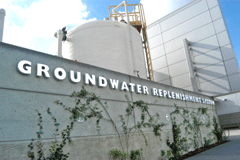
Orange County will soon use purified wastewater to replenish sinking groundwater (Photo: Orange County Water District)
GELLERMAN: Shortages of water in Southern California had officials looking in some unlikely—and perhaps unsavory—places.
[SOUND OF TOILET FLUSHING]
GELLERMAN: The squeamish call it ‘toilet to tap.’ The correct term is ‘indirect potable water reuse.’ That’s a mouthful. And in a few days 2.3 million people in Orange County California will begin quenching their thirst with it. Living on Earth’s Ingrid Lobet reports.
LOBET: It's the basic tenet of public health—keep your water and sewer separate. Yet Orange County water and sewage treatment officials have found the closer they work together, the better.
WILDERMUTH: Because of growing population, we knew that we need to put more water in the groundwater basin. And so 10, 13 years ago, we started looking around.
LOBET: That's Ron Wildermuth of the Orange County Water district. In the mid 1990s, his department saw that it was pumping fresh water out of the ground at an unsustainable rate. At the same time, the county sanitation department was looking at building a second concrete pipe to carry its partially-treated sewage out to the ocean.
WILDERMUTH: So you had one water agency needing water. You had a sanitation district that was going to have to build another pipe to dispose of more water. So they came together and said ‘why don't we take that water, purify it, and then you won't have to build the ocean outfall.’

Orange County will soon use purified wastewater to replenish sinking groundwater (Photo: Orange County Water District)
[SOUND OF FLOWING WATER]
HELLEBRAND: This water now is what will be sent over to the water districts. So we're at the end of the water process.
LOBET: Now, more than a decade later, Ingrid Hellebrand of the Orange County Sanitation District points with pride at her finished product—strained, settled, aerated and skimmed into a goldish but clear liquid. Hellebrand calls the stuff she deals with everyday ‘water.’ Does she really think of it as water?
HELLEBRAND: Yeah, it’s, it’s water!
LOBET: Well, 99.9 percent water. There is .1 percent of something else.
HELLEBRAND: When you flush the toilet, when you brush your teeth, the water just goes away. And nobody really thinks about where away is, but that’s where I work—where ‘away’ is. And the school kids come through, and they're kind of looking for that yuck factor. And by the time they get to the end of the process and they see that the water is so clean—you almost want to drink it! (laughs)
LOBET: And from here, the end of the sewage treatment process, it gravity-drains to the water utility, right next door. There, three things happen. None by itself is unique or too remarkable but taken together, and used on wastewater, it's the largest project of its kind in the world. First the water is sucked up into thousands of stringy straws with perforated sides.
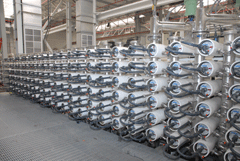
In reverse osmosis (RO), water molecules are forced through plastic film. (Photo: Orange County Water District)
LOBET: Bugs like protozoa and bacteria in the water can't fit though the holes. So every 22 minutes the airflow reverses to blow instead of suck, to clean the holes. The impurities are promptly sent back across the property line to the sewage treatment plant. Ron Wildermuth of the Water District loves the sound.
WILDERMUTH: It's like an orchestra.
LOBET: Music to your ears?
WILDERMUTH: Yes it is! (laughs)
LOBET: Next, the water passes though chambers for reverse osmosis. That means the water molecules are actually forced, under intense pressure, through a sheet of plastic. Wildermuth says not much besides tiny water molecules can pass through.
WILDERMUTH: If you size a water molecule the size of a tennis ball, your pharmaceuticals, hormones, pesticides—would be the size of a soccer ball. Okay? A virus would be the size of a tractor-trailer truck. So basically we’re physically not allowing viruses, uh, fertilizers, pesticides, hormones, or pharmaceuticals to get through because they can't get through the plastic sheet.
LOBET: Last, the water is exposed to ultraviolet light and mixed with peroxide. That zaps two compounds that manage to get this far for final cleaning. The engineers here at the water utility brought all this new equipment online over the last three months. The day before my visit had been a milestone. For the first time they'd injected their new purified water underground. William Dunivin is in charge.
DUNIVIN: To see it all come together after so many years it’s like, I can't explain it. And just the fact that it's such a, a timely event for the world to see this. I mean, with water becoming such an issue throughout the world. And this is a viable way to do it, and safely.
LOBET: A steady stream of visitors from around the globe tour the project. At home, it's been the focus of an intense public relations, okay, public education campaign. Again, Ron Wildermuth.
WILDERMUTH: We thought we could convince the people this was a good idea, and we did.
LOBET: How did you do that?
WILDERMUTH: Face to face talks for ten years to everybody that would listen. We talked to the historical society. We talked to the chambers. We talked to the flower committee. If there was a group, we talked to them.
LOBET: And consistent with the positive message, the water district has a stainless steel tap ready for a taste at the end of every tour.
WILDERMUTH: Very good water.
LOBET: For those not persuaded by the positive, consider this: many of us are already drinking water that was discharged as treated sewage into a river, and then tapped and purified downstream.
WILDERMUTH: Las Vegas puts like 200,000 gallons of wastewater in Lake Mead every day. And that comes down to us. It’s nothing new.
LOBET: But we haven't been talking that much about it.
WILDERMUTH: You're darn right we haven't. But, you know, it's a fact of life.
LOBET: For Living On Earth, I'm Ingrid Lobet in Fountain Valley, California.
Related links:
- Groundwater Replenishment System
- Orange County Sanitation District
- Orange County Water District
Water Calculator

Wenonah Hauter (Courtesy of Food and Water Watch)
GELLERMAN: Well if toilet to tap isn't exactly your cup of tea, you might want to train yourself to use less water. To learn just how much water you're currently using you can go online to the new website h2oconserve.org.
Wenonah Hauter is executive director of Food and Water Watch—one of four public service organizations that created this nifty online calculator. Welcome to Living on Earth, Wenonah.
HAUTER: I’m glad to be here.
GELLERMAN: Well I have a laptop in the studio here and I’m on your site, h2oconserve.org. There are what 19 questions and, let’s see, I’ve already entered where I live, which ironically I’ve got to tell you, is Watertown, Massachusetts. How many people in my home, okay; how many minutes we spend singing in the shower. Do we turn the water off when brushing our teeth? Do you turn the water off when you brush your teeth?
HAUTER: You know, I do. I’ve become very water conscious.
GELLERMAN: Okay. Well, now it takes me to one—let’s see, ‘do the people in your household let it mellow?’ Hmm, what does that mean?
HAUTER: Well, it means do you flush the toilet every time? Toilets use a lot of water.
GELLERMAN: Well, okay, let’s see. Always, sometimes, never.
HAUTER: Toilets use about 27 percent of the water that we use in the house.

Wenonah Hauter (Courtesy of Food and Water Watch)
GELLERMAN: Well, okay. I’ve answered that question. Do I have a lawn or a garden? I see. Do you have a lawn or garden? You’re in D.C.
HAUTER: Actually I live in a farm in Virginia, so I have a garden and we farm.
GELLERMAN: Alright. Well, let’s see. I’ve answered that one. Do I have a swimming pool? No. Do I have a car? What does a car have to do with my water?
HAUTER: Well, oil and gas takes a lot of water to process and making a car takes water.
GELLERMAN: Okay, it’s asking if I wash my car. One time a year! (laughs)
HAUTER: (laughs)
GELLERMAN: Now it asks what the dietary habits of the people in the household are. What does that have to do—whether I eat meat or dairy?
HAUTER: Well, you know, the way that we eat it really determines how much water we’re using. If you’re eating imported fruits or vegetables from someplace like Mexico or Chile or even California, that’s almost virtual water trade because it takes a lot of water to produce those crops. Meat takes the most water to produce. If you look at something like beef—it takes about 60 gallons of water to produce a pound of corn. Cows eat a lot of corn and it also takes water for them to be cleaned, for the meat to be processed, for them to drink. And so each pound of beef takes about 1500 gallons of water to produce. So the choices that you make—if you eat lower on the food chain, grains and vegetables—you’re using less water.
GELLERMAN: Well here I’ve finished! It says, ‘you’ve completed the calculator.’ Here are my results: ‘your total household water use is 32 hundred and 52 gallons per day. Individual use is eight hundred and 13 gallons per day.’ 32 hundred and 52 gallons a day for four people?!
HAUTER: Well your individual use is below the national average, which is one thousand one hundred and 89 gallons a day. Americans use a lot of water. Contrast that with someone who lives in Ethiopia who uses just over a gallon a day. The World Health Organization says that to have any kind of decent standard of living, a person needs 12 to 13 gallons a day and for developing countries to have sustainable development, they need twice that. So you can see that we’re using a lot of water and becoming water conscious is very important.
GELLERMAN: You have some tips here on how to reduce my water footprint. And give me two tips—really things that I could do right away, not going to cost me a lot of money but that are going to save me a lot of water.
HAUTER: Well, you can reduce the amount of water that you use in your house by investing in a low-flow toilet or by putting a plastic bottle filled with water in your toilet tank. Those are the types of things around your household. Recycling is also one way that you can meet a number of goals—reducing the amount of trash in the landfill, and using less water on manufactured products.
GELLERMAN: Hey, Wenonah, how much water do you use a day?
HAUTER: You know, I use about 900 gallons because I have a car, because I live in the country and drive into Washington—that’s one of my bigger water uses.
GELLERMAN: Well, I beat you!
HAUTER: (laughs) You sure did!
GELLERMAN: Well thank you, Wenonah. Appreciate it very much.
HAUTER: Okay. Thank you.
GELLERMAN: Wenonah Hauter is the executive director of Food and Water Watch based in Washington, D.C. You can find a link to the h2oconserve website at loe.org.
Related links:
- H2O Conserve- the site that features the water calculator
- Food and Water Watch
[MUSIC: The Uptown String Quartet “Tricotism” from Max Roach Presents The Uptown String Quartet (PolyGram Records, Inc. 1989)]
GELLERMAN: You can listen to our program anytime on our website or get a download for your mp3 player. The address is loe.org. That’s L-O-E-dot-O-R-G. And you can reach us at comments@loe.org. Once again, comments@loe.org. Our postal address is 20 Holland Street, Somerville, Massachusetts, 02144. And you can call our listener line at 800-218-9988. That’s 800-218-9988.
Coming up—wireless technology to fill-in the missing links. Stay tuned to Living on Earth!
ANNOUNCER: Support for the environmental health desk at Living on Earth comes from the Cedar Tree Foundation. Support also comes from the Richard and Rhoda Goldman Fund for coverage of population and the environment. This is Living on Earth on PRI: Public Radio International.
Geophonic Works
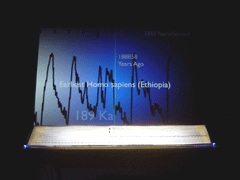
Arvid Tomayko-Peters most recent project turned data from eight deep-ocean sediment cores into an experimental geo-music exhibition. A giant screen tracked data going back 5.3 millions years and flashed events from Earth's history that corresponded to the chronology of the data--like the birth of Homo Sapiens 188,858 years ago. (Courtesy of Arvid Tomayko-Peters)
GELLERMAN: It’s Living on Earth, I’m Bruce Gellerman.
[MUSIC: VOSTOK BLUES]
GELLERMAN: You’re listening to a duet inspired by data reaching back millions of years. Arvid Tomayako-Peters has created a computer program that transforms geological data about climate change, carbon dioxide levels and ice temperatures, into music.
TOMAYAKO-PETERS: In Geology you have these layers stacked one on top of the other, and each one of them is a little bit different. So I approach this sort of like a score in music.
GELLERMAN: Arvid Tomayako-Peters graduated from Brown University last year with a dual degree in computer music and geology. As part of his senior thesis he created geo-music software. Ian Gray visited Arvid’s studio and produced this audio portrait.
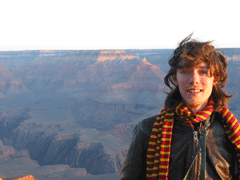
Arvid Tomayko-Peters in front of the Grand Canyon(Courtesy of Arvid Tomayko-Peters)
TOMAYKO-PETERS: I’ve always loved science. And sort of the fact that I got involved in geology at Brown was an accident. I took a climate change freshman seminar and I was like, “yes this is fantastic.” I got into all that stuff like looking at ice ages and global warming.
TOMAYKO-PETERS: Then I started to write this meistrofranksnstein software, which is a multi track sequencer for scientific data instead of music.
[MUSIC: POND CORE METAL]
TOMAYKO-PETERS: What we’re listening to is abundances of different elements then a column of mud from the bottom of a pond in Rhode Island. There’s twelve metals that we found in this mud that we’re concerned about such as chromium, arsenic and lead. Each metal is like a finger on a piano key. So in this case we have twelve fingers. You can see sort of at the end of the piece that a lot of the pitches get lower. That is an indication of less pollution because of less industry back 150 years ago when that sediment was laid down.
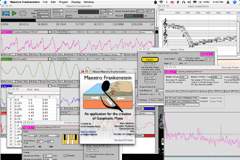
Maestro Frankenstein: the software program that Arvid Tomayko-Peters' created to write his music.
(Courtesy of Arvid Tomayko-Peters)
[KEYBOARD TAPPING]
TOMAYKO-PETERS: So, I’m going to create a very little simple piece on the spot. I’m going to play you some data from the Vostok ice core in Antarctica. And turning that into music and I’m going to play it along side the record of global ice volume.
[MUSIC: VOSTOK BLUES]
TOMAYKO-PETERS: So the string instrument that you’re hearing is the amount of carbon dioxide. And the tinkly xylophone-like synthesized instrument is the amount of ice. So the two instruments play opposite one another. When one is going down the other is going up through several ice ages. The time period that I’m going to play is the time that Homo sapiens has been in existence, the last about 195,000 years.
[MUSIC: VOSTOK BLUES CONTINUES]
TOMAYKO-PETERS: Now when the stringed instrument, carbon dioxide increases, there’s not very much ice. And when the pitch of this xylophone-like instrument is higher, there’s more ice on the poles. The data that I’m using here shows this really tight correlation between the amount of carbon dioxide and the amount of ice at the poles on the earth.

Arvid Tomayko-Peters most recent project turned data from eight deep-ocean sediment cores into an experimental geo-music exhibition. A giant screen tracked data going back 5.3 millions years and flashed events from Earth's history that corresponded to the chronology of the data--like the birth of Homo Sapiens 188,858 years ago.
(Courtesy of Arvid Tomayko-Peters)
The latest piece I’ve been putting a lot of work into was an interactive installation, where visitors would come in and hear eight deep ocean cores being played back as sound. And it’s a very sort of ethereal piece. You come in, you listen and there’s no notes. Everything is continuous tone and just constantly changing pitch.
[MUSIC: CLIMATE CONTROL EXHIBIT]
TOMAYKO-PETERS: Visitors come in and they can interact with a large timeline which they touch and go to any point in time. And what they hear are climate records played back on 8 speakers that surround them. And they see visuals that show them what’s going on in the climate then. You can see an ice age then everything turns blue in the entire room. And in warm periods everthing turns red. And what sort of evolutionary events are happening, weather when the first Homo sapiens are, where the first rhinos enter America, things that they might identify with somewhat.
[CLIMATE CONTROL CONTINUES]
TOMAYKO-PETERS: One of the wonderful things I think this music gives a listener a chance to do is relate to and experience this inconceivably long amount of geologic time that there have been. I mean a million years, you can’t even imagine that. And that’s just a tiny portion of the earth’s history going back 4.5 billion years. So, if you condense it down to something where you can experience that time in thirty seconds or five minutes it just sort of brings that time frame home, and makes you realize how absolutely short your existence is.
[MORE GEOLOGIC SOUNDS]
GELLERMAN: Our portrait of Arvid Tomayko-Peters was produced by Ian Gray.
Related link:
Tomayko-Peters' website
Cool Fix For a Hot Planet
[THEME MUSIC]
GELLERMAN: In the segment we call “Cool Fix for a Hot Planet” we highlight ways you can take action against climate change. Sandy Kappelman listens to Living on Earth on KQED in San Francisco. We liked the Cool Fix she emailed. So we called her up.
KAPPELMANN: We’re using our dishwasher in a new way these days. Instead of using large amounts of water and electricity to run full loads and dry them, we now hand wash our dishes each night in biodegradable liquid dish soap, using a small sink full of hot, soapy water. Then we rinse off all the dishes at the same time. The dishwasher has become a giant dish drainer. We leave the racks open at night and by morning all the dishes are air-dried. We’ve noticed our utility bills are smaller and the amount of water we’re using is less. So by going green we’re saving some green, too. We love using lavender earth-friendly dish soap instead of powder dishwasher detergent. Our dishes are cleaner now than they ever were when we were using the dishwasher in the usual way.
GELLERMAN: Well, thanks, Sandy. And for your cool fix, we're sending you a sleek blue Living on Earth tire gauge. If you use it to keep your tires correctly inflated, it could save you as much as $432 a year. That's according to a study from Carnegie Mellon University. If you have a Cool Fix for a Hot Planet, let us know. If we use your idea on the air, you too will get a LOE tire gauge.
Call our listener line at 800-218-99 88, that's 800-218-9988. Or email coolfix— that’s one word—at loe.org. That's coolfix at loe.org.
Wireless Science
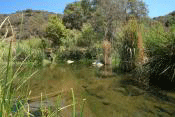
The creek in the Santa Margarita Ecological Reserve in San Diego County, California that hosts the water quality probes. (Photo: Monika Braun)
GELLERMAN: To probe nature’s closest-held secrets and gather data, scientists sometimes have to trek into remote and forbidding places. But once there – they’ve got another problem - getting all that data home. As Spectrum Radio’s Jean Kumagai reports, researchers now have a new, faster system to retrieve and transmit data – that just might transform the way they do science.
[SOUND OF WALKING ON GRAVEL, MAN SAYS ‘BE CAREFUL, THERE’S SOMETIMES SNAKES THERE . . . ‘]
KUMAGAI: Hans Werner Braun picks his way along a bramble-covered path at the Santa Margarita Ecological Reserve in San Diego County, California. He stops at the edge of a cliff, and looks down to a river below.
[SOUND FROM BABBLING BROOK]
KUMAGAI: Braun, a computer scientist at the University of California San Diego, says that this is one of the last free-flowing rivers in Southern California. The water burbles along through a narrow, cactus-studded gorge. It’s the dry season, so the river is more of a shallow creek at the moment. The idea is to keep the river and its surroundings as pristine and close to their natural state as possible. That’s where Braun comes in.
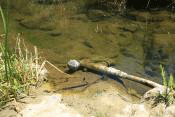
One of the probes used to sample the stream.(Photo: Monika Braun)
KUMAGAI: Over the past seven years, Braun and a few colleagues have built a high-speed wireless network linking up dozens of sites throughout San Diego County. It’s called the High Performance Wireless Research and Education Network, or HPWREN, and it allows researchers to monitor the tiniest facets of Santa Margarita’s ecosystem.
BRYANT: There’s little fishes in here, craw-dads, all kinds of neat stuff.
KUMAGAI: San Diego State University biologist Pablo Bryant collaborated with Braun. Kneeling down at the river’s edge, he pulls a steel pipe up from the water.
BRYANT: This is essentially a multiprobe. Stainless steel. Screw the top off. And you can see it’s got four probes in there, and these four probes have pH, dissolved oxygen, conductivity, and temperature.
KUMAGAI: The probes sample the stream every five seconds, and within half a minute, the data is sent through HPWREN and can then be accessed via the Web by researchers anywhere in the world. The reserve now boasts two other water quality probes, as well as 30 weather stations, more than a dozen remote cameras and wildfire detectors, and seismic sensors. Each device has a particular use. The cameras, for instance, are triggered by motion detectors, and they record any wildlife that happens to wander by the lens, such as hawks in flight and coyotes on the prowl. Data from all the sensors passes in and out of the reserve, via HPWREN, at a lightning fast 45 megabits per second. The use of wireless sensors and networks, Bryant says, is creating a paradigm shift in field research.
BRYANT: There’s two things that are happening. You’re getting the data in real time, so you can see if a sensor fails or if your data is good. And you can also have many more sensors in the field. And all we’re trying to do as technologists is create an infrastructure in a way to attract scientists to kind of do science in a new direction.
KUMAGAI: Looking at an aerial map of San Diego County, it’s easy to see why HPWREN has been so successful. The county covers some 4,500 square miles—about twice the size of Delaware—and the rugged geography makes it difficult for regular telecom companies to offer service at remote sites. That same forbidding terrain is ideal for the mountaintop radio antennas that form the backbone of HPWREN.
The network isn’t just being used to study conditions on the ground. At the northern end of the county, atop Palomar Mountain, it’s also helping astronomers gaze at the stars.

The creek in the Santa Margarita Ecological Reserve in San Diego County, California that hosts the water quality probes. (Photo: Monika Braun)
[SOUND OF CAR DOORS SLAMMING]
KUMAGAI: Braun drives his Jeep 4-by-4 up a winding mountain road, to Palomar Observatory. A scattering of gleaming white domes stands in a clearing. The observatory’s been operating since 1949, but newer, more powerful telescopes in Hawaii, Chile, and out in space threatened to eclipse older sites like Palomar. Spokesman Scott Kardel says connecting to HWPREN helps keep the observatory competitive.
SCOTT KARDEL: It’s through this antenna that we actually can move massive amounts of data and have automated telescopes that hunt for asteroids and look for planets around other stars and allows us to be an effective modern observatory, even on telescopes like this one that are 60 years old.
KUMAGAI: With the HPWREN connection, researchers can now do what’s called “rapid response astronomy”. Because astronomers can access their data almost immediately, instead of days or even months later, they can look for fleeting or fast-evolving phenomena, like asteroids and supernovas. If they happen to spot something interesting, they can track that patch of sky over consecutive nights or call up more sensitive instruments to take a closer look.
KARDEL: On the right is our 60-inch telescope and that’s automated to be a rapid responding telescope for gamma-ray bursts. So there’s a NASA satellite called SWIFT that locates them and sends a message directly to the computer there. And if the object is visible at Palomar and the weather is ok, it’ll stop what it’s doing and catch it. Usually it can be there making a measurement of the gamma ray burst within two minutes of the satellite having detected it.
KUMAGAI: Kardel says HPWREN’s high bandwidth is giving new life to old telescopes. And scientists aren’t the only people benefiting from the wireless network. Indian reservations, the San Diego Sheriff’s Department, and several state wildfire command centers are now connected, too. And, thanks to HPWREN, school children are able to explore places like Santa Margarita and Palomar right from their classrooms. Although Braun started the project as an academic exercise in computer networking, it’s these real-world applications that keep him going.
BRAUN: My background is really in computer networking. It’s not wireless and it’s certainly not sensors. But what is really interesting to me is being able to work with the applications, work with the ecological reserves, work with the astronomers, work with Native Americans, work with first responders, and so on. See what they really need, and come up with some cool new sensors that we deploy and develop together and make it work together.
KUMAGAI: Braun says he’s happy to foster as many new research and educational connections as his network will allow. For Living on Earth, I’m Jean Kumagai.
GELLERMAN: Our piece on the wireless network comes to us courtesy of Spectrum Radio, the broadcast edition of IEEE Spectrum, the magazine of technology insiders.
Related links:
- HPWREN website
- Hans-Werner Braun bio
[MUSIC: Tapani Varis “Fanitullen” from Nordic Roots 1998 (NorthSide 1998)]
GELLERMAN: On the next Living on Earth—reviewing the science in science fiction films.
VIDEO SOUND: We interrupt this program to give you a bulletin just received from one of our naval units at sea: A large object travelling at supersonic speed is headed over the north Atlantic, towards the east coast of the united states. (The Day the Earth Stood Still, 1952)
GELLERMAN: Thumbs up or thumbs down? - A century of Hollywood Science – next time on Living on Earth.
[MUSIC: (“Windchimes in the Rain” King Tet ® Productions, Ltd. © 2004)]
We leave you this week in a mid-winter night’s rain.
[MUSIC: (“Windchimes in the Rain” King Tet ® Productions, Ltd. © 2004)]
Eric Van der Wyk recorded this California rainstorm for a cd he calls “Wind Chimes in the Rain.” And you say we’re all wet!!!
GELLERMAN: Living on Earth is produced by the World Media Foundation. Our crew includes Ashley Ahearn, Bobby Bascomb, Eileen Bolinsky, Ingrid Lobet, Helen Palmer, Emily Taylor, and Jeff Young, with help from Jennifer Baessler and Sarah Calkins. Our interns are Kathleen O’Neill, Annie Jia, and Margaret Rossano. Today’s show was engineered by Noel Flatt.
Jeff Turton is our technical director. Alison Lirish Dean composed our themes. Steve Curwood is our executive producer. You can find us at loe.org. I’m Bruce Gellerman. Thanks for listening.
ANNOUNCER: Funding for Living on Earth comes from the National Science Foundation, supporting coverage of emerging science; And Stonyfield Farm Organic yogurt and smoothies. Stonyfield pays its farmers not to use artificial growth hormones on their cows. Details at Stonyfield.com.
Support also comes from you our listeners, the Ford Foundation, The Town Creek Foundation, the Oak Foundation supporting coverage of climate change and marine issues. And Pax World mutual funds, socially and environmentally sustainable investing. Pax World, for tomorrow. On the web at paxworld.com.
ANNOUNCER 2: PRI, Public Radio International.
Living on Earth wants to hear from you!
Living on Earth
62 Calef Highway, Suite 212
Lee, NH 03861
Telephone: 617-287-4121
E-mail: comments@loe.org
Newsletter [Click here]
Donate to Living on Earth!
Living on Earth is an independent media program and relies entirely on contributions from listeners and institutions supporting public service. Please donate now to preserve an independent environmental voice.
Newsletter
Living on Earth offers a weekly delivery of the show's rundown to your mailbox. Sign up for our newsletter today!
 Sailors For The Sea: Be the change you want to sea.
Sailors For The Sea: Be the change you want to sea.
 The Grantham Foundation for the Protection of the Environment: Committed to protecting and improving the health of the global environment.
The Grantham Foundation for the Protection of the Environment: Committed to protecting and improving the health of the global environment.
 Contribute to Living on Earth and receive, as our gift to you, an archival print of one of Mark Seth Lender's extraordinary wildlife photographs. Follow the link to see Mark's current collection of photographs.
Contribute to Living on Earth and receive, as our gift to you, an archival print of one of Mark Seth Lender's extraordinary wildlife photographs. Follow the link to see Mark's current collection of photographs.
 Buy a signed copy of Mark Seth Lender's book Smeagull the Seagull & support Living on Earth
Buy a signed copy of Mark Seth Lender's book Smeagull the Seagull & support Living on Earth

